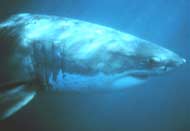Older stories on Resources News
Links to general resource, environmental sites
Links to non-profit environmental/resource groups
Links to environmental/resource news sources
E-mail Resources News
White sharks well traveled
New study shows white sharks migrate much further than previously believed.
A new study is shattering old beliefs about the great white shark - one of the largest, most awe-inspiring predators in the sea. Scientists studying white sharks along the California coast have long believed that these powerful carnivores spend most of their lives relatively close to shore, pursuing seals and sea lions.
But a recent study reveals that white sharks can range across vast stretches of open ocean. In fact, one male tagged along the Central California coast migrated thousands of miles to the warm waters off Hawaii - and remained there for nearly four months.
"The migrations and environmental preferences of white sharks have remained elusive," observed Barbara Block, of the Tuna Research and Conservation Center, a joint project of Stanford University and the Monterey Bay Aquarium. "Until this study, white sharks had only been tracked for a few days around seal colonies. With the advent of new electronic tagging technology, we can now track their movement, depth and temperature preferences over many weeks and months".
"I was shocked by the results," noted UCSC biologist Burney Le Boeuf Davis of the Institute of Marine Sciences at the University of California-Santa Cruz. "Going into this, what we expected was that white sharks were just coastal animals that breed in Southern California, then migrate a few hundred miles north to feed on seals. But it turns out they've got a life at sea, and when they're in the open ocean, they're diving very deep at times."
To monitor long-distance migrations, researchers attached "pop-up" satellite archival tags to the backs of six adult white sharks near seal rookeries in California between 1999 and 2000. The electronic tags recorded data every two minutes on water depth, temperature and light.
Each tag was programmed to detach from the animal on a specific date, then pop up to the surface, where the data were transmitted via the Argos satellite system to computers at Hopkins Marine Station. That data confirmed that, in the fall, white sharks appear near coastal seal rookeries at Año Nuevo and the Farallones just as young elephant seals arrive to rest prior to the annual mating ritual of adult seals. Data showed that, while near shore, tagged sharks rarely dove more than 90 feet (30 meters) below the surface.
The surprise came in winter when four sharks tracked for longer durations all headed offshore into the central and eastern Pacific. White sharks have only rarely been reported in recent times in Hawaii where one shark went, but ancient cultures had tools that were made from white shark teeth, so it's clear they have been around the islands for some time.
Three other tagged sharks - two females and a male - migrated to a subtropical region of the eastern Pacific hundreds of miles west of Baja California. The three sharks remained in the open ocean for several months, never venturing near any coastline.
"What they were doing out there is a mystery," noted Le Boeuf. "Since they were hunting for seals when tagged, such a long migration suggests a possible rendezvous for mating, or a move to feed on different prey."
The sharks spend at least five months in the open ocean, suggesting that it could be an important period in the life history of white sharks in the North Pacific. "This is coming at an important time, as white sharks - along with many open-ocean animals - require increased protection from international fisheries," concluded Block. "The first step in protecting their future on Earth is knowing where they go.
